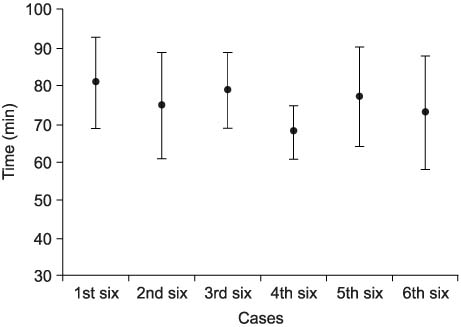Korean J Urol.
2006 Jun;47(6):635-639. 10.4111/kju.2006.47.6.635.
Video Assisted Minilaparo-Ureterolithotomy in 36 Upper Ureteral Calculi
- Affiliations
-
- 1Department of Urology, College of Medicine, Chung-Ang University, Seoul, Korea. moon13579@hanafos.com
- KMID: 2294239
- DOI: http://doi.org/10.4111/kju.2006.47.6.635
Abstract
-
PURPOSE: Most cases of urolithiasis are successfully managed with extracorporeal shock wave lithotripsy (ESWL), ureterorenoscopic lithotripsy and percutaneous nephrolithtomy. However, in patients whose calculi are not managed by these methods, an open ureterolithotomy still plays a considerable role. We performed video assisted minilaparo (VAM)-ureterolithotomy in 36 patients with upper ureteral calculi.
MATERIALS AND METHODS
Between January 2001 and July 2005, VAM-ureterolithotomy was performed in 36 patients with upper ureteral calculi. We retrospectively analyzed the operating times, postoperative hospital stay, number of postoperative analgesics, incisional size, complications and the degree of improvement in these patients.
RESULTS
The stones of all the patients were successfully removed using VAM-ureterolithotomy through a minimal 4cm skin incision. The mean operative time and postoperative hospital stay were 75 minutes and 3.9 days, respectively. The mean analgesic requirement was 69mg of ketorolac. Compared to a conventional ureterolithotomy, the VAM-ureterolithotomy required a similar operating time, but less analgesics and a shorter postoperative hospital stay. There were no significant complications associated with the VAM-ureterolithotomy.
CONCLUSIONS
A VAM-ureterolithotomy is a safe and effective minimally invasive procedure, which may be considered as an alternative treatment technique to a conventional ureterolithotomy and laparoscopic ureterolithotomy in cases where first-line treatments have failed or are unlikely to be effective.
MeSH Terms
Figure
Reference
-
1. Paick ML, Wainstein MA, Spirnak JP, Hampel N, Resnick MI. Current indications for open stone surgery in the treatment of renal and ureteral calculi. J Urol. 1998. 159:374–378.2. Park HK, Oh SJ, Kim HH. Laparoscopic retroperitoneal ureterolithotomy. Korean J Urol. 2002. 43:287–290.3. Gaur DD, Trivedi S, Prabhudesai MR, Madhusudhana HR, Gopichand M. Laparoscopic ureterolithotomy: technical considerations and long-term follow-up. BJU Int. 2002. 89:339–343.4. Demirci D, Gulmez I, Ekmekcioglu O, Karacagil M. Retroperitoneoscopic ureterolithotomy for the treatment of ureteral calculi. Urol Int. 2004. 73:234–237.5. Feyaerts A, Rietbergen J, Navarra S, Vallancien G, Guillonneau B. Laparoscopic ureterolithotomy for ureteral calculi. Eur Urol. 2001. 40:609–613.6. Lee JH, Lee DH, Suh HJ. Ureterolithotomy using laparoscopy assisted small incision in upper ureter stone. Korean J Urol. 1999. 40:683–686.7. Chaussy C, Schuller J, Schmiedt E, Brandl H, Jocham D, Liedl B. Extracorporeal shock wave lithotripsy (ESWL) for treatment of urolithiasis. Urology. 1984. 23:59–66.8. Chaussy C, Schmiedt E. Shock wave treatment for stones in the upper urinary tract. Urol Clin North Am. 1983. 10:743–750.9. Segura JW, Preminger GM, Assimos DG, Dretler SP, Kahn RI, Lingeman JE, et al. Ureteral stones clinical guidelines panel summary report on the management of uretreral calculi. J Urol. 1997. 158:1915–1921.10. Politis G, Griffith DP. ESWL: stone-free efficacy based upon stone size and location. World J Urol. 1987. 5:255–258.11. Singal RK, Denstedt JD. Contemporary management of ureteral stones. Urol Clin North Am. 1997. 24:59–70.12. Park MS, Park HK, Park TH. Two-year experiences of ureteral stone, SWL versus ureteroscopic manipulation. Korean J Urol. 1998. 39:879–884.13. Park CM, Ryu SH, Jeon SS, Chai SE. Comparison of extracorporeal shock wave lithotripsy and ureteroscopic lithotripsy for treatment of upper ureteral calculi. Korean J Urol. 2001. 42:379–383.14. Liong ML, Clayman RV, Gittes RF, Lingeman JE, Huffman JL, Lyon ES. Treatment options for proximal ureteral urolithiasis: review and recommendations. J Urol. 1989. 141:504–509.15. Preminger GM. Management of ureteral calculi: the debate continues. J Urol. 1992. 148:1102–1104.16. Mobley TB, Myers DA, Jenkins JM, Grine WB, Jordan WR. Effects of stents on lithotripsy of ureteral calculi: treatment results with 18,825 calculi using the Lithostar lithotriptor. J Urol. 1994. 152:53–56.17. Farsi HM, Mosli HA, Alzimaity M, Bahnassay AA, Ibrabim MA. In situ extracorporeal shock wave lithotripsy for primary ureteric calculi. Urology. 1994. 43:776–781.18. Erhard M, Salwen J, Bagley DH. Ureteroscopic removal of mid and proximal ureteral calculi. J Urol. 1996. 155:38–42.19. Segura JW. Percutaneous nephrolithotomy: technique, indications, and complications. AUA Update Series. 1993. 12:154–159.20. Wittgen CM, Andrus CH, Fitzgerald SD, Baudendistel LJ, Dahms TE, Kaminski DL. Analysis of the hemodynamic and ventilatory effects of laparoscopic cholecystectomy. Arch Surg. 1991. 126:997–1001.21. Raboy A, Ferzli GS, Ioffreda R, Albert PS. Laparoscopic ureterolithotomy. Urology. 1992. 39:223–225.22. Gaur DD, Agarwal DK, Purohit KC, Darshane AS, Shah BC. Retroperitoneal laparoscopic ureterolithotomy for multiple upper mid ureteral calculi. J Urol. 1994. 151:1001–1002.23. Jones DA, George NJ, O'Reilly PH, Barnard RJ. The biphasic nature of renal functional recovery following relief of chronic obstructive uropathy. Br J Urol. 1988. 61:192–197.24. Holm-Nielsen A, Jorgensen T, Mogensen P, Fogh J. The prognostic value of probe renography in ureteric stone obstruction. Br J Urol. 1981. 53:504–507.
- Full Text Links
- Actions
-
Cited
- CITED
-
- Close
- Share
- Similar articles
-
- The Risk Factors of Ureteral Stricture after Treatment for Ureteral Calculi
- Transverse Ureterolithotomy
- Experience of Ureteroscopic Removal of Ureteral Stone in 35 Cases
- Review or Ureteral Obstruction during ESWL Monotherapy without Ureteral Stenting for Staghorn Calculi
- Ureterolithotomy Using Laparoscopy Assisted Small Incision in Upper Ureter Stone


